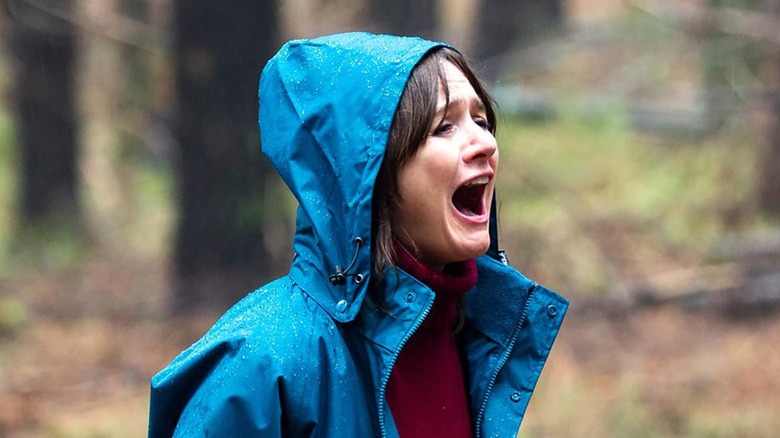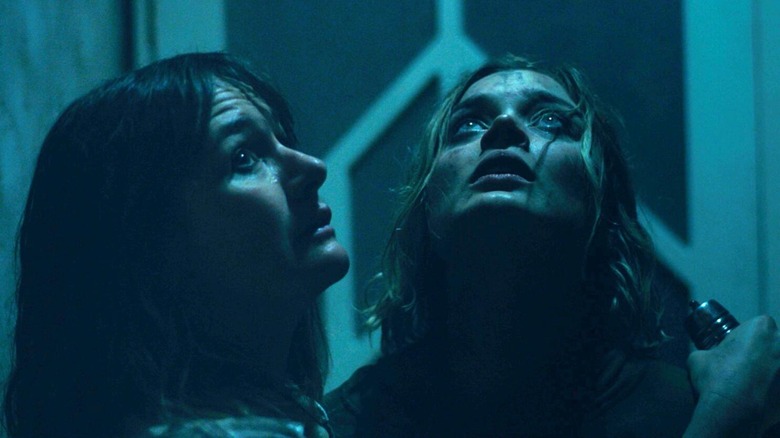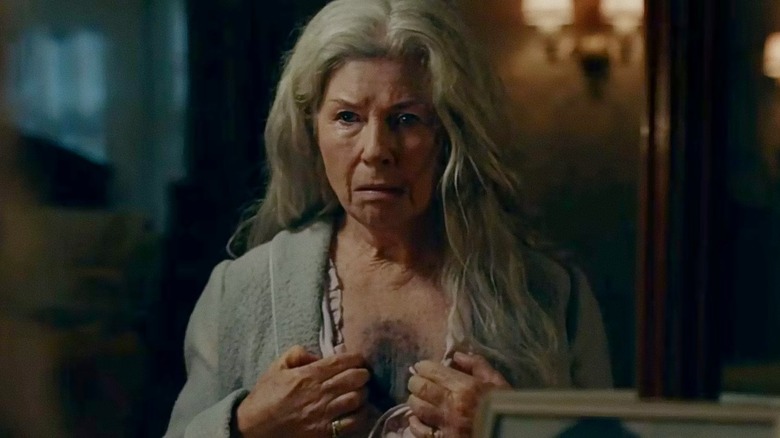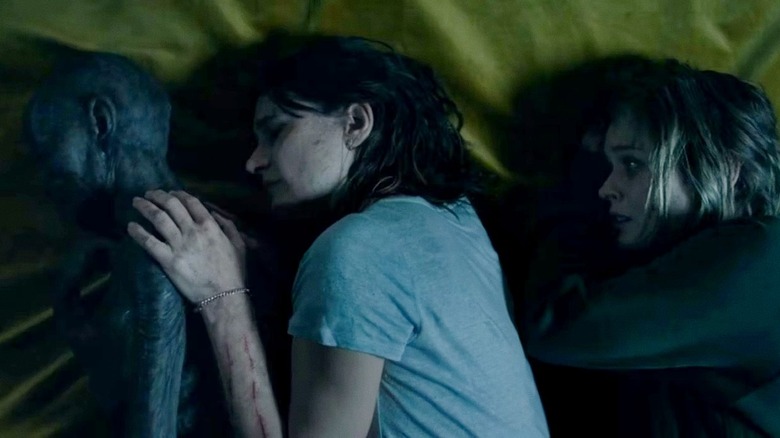Relic Ending Explained: Beware The Black Spot
Directed by Japanese-Australian filmmaker Natalie Erika James, "Relic" features many familiar horror tropes: a mysterious elderly woman; a dark, decaying house with hidden passageways; and strange and unexplained occurrences that might be the work of paranormal forces. But this is not a typical haunted house movie about the struggle between good and evil. As James explained in an interview with Refinery29 when the film first released:
"I'm trying to find inventive ways to earn the scare that's psychologically scary rather than a loud noise that makes you jump no matter what the image is. Time, and what it does to those we love, is the true villain of this story — if one can even call it that. There's nothing evil in the film, really. It's not so simple."
Instead, "Relic" explores the bone-chilling inevitability of growing old — both observing this process with your parents, and potentially losing your own memories and life history. Within this intergenerational tale of a grandmother, mother, and daughter, James taps into psychological and emotional terrors that are achingly universal, making "Relic" a devastating portrayal of the passage of time and the challenges of caregiving. Slow-moving and highly emotional, this horror film is far more contemplative than a typical installment in the genre. "Relic" cleverly uses traditional horror conventions to portray this highly emotional and disturbing nature of grief.
What you need to remember about the plot of Relic
Kay, along with her daughter Sam, searches for her missing mother, Edna, in the Australian countryside. The title "Relic" refers to a piece of stained glass window taken from a cabin where Kay's great-grandfather, who suffered from mental health issues, was abandoned and left to decompose. A haunting image of his body reoccurs in Kay's dreams, as if she is questioning whether her mother will be left to suffer the same lonely fate. (There's plenty of subtext to the title as well.)
The memory of her great-grandfather's tragic end hangs like a shadow over Kay as she grapples with the perfect storm of emotions — guilt, resentment, and sadness — that comes with caring for an elderly family member. Kay shielded herself from the painful experience of witnessing her mother's deterioration by burying herself in her work. This neglect led to Edna wandering in the woods, accidentally locking her neighbor's young son in a cupboard for hours, and needing countless Post-it notes scattered around the house as reminders for even the most basic of tasks. Kay contemplates leaving her mother at an elderly care facility in Melbourne, but Sam believes it would be cruel to abandon a family member; she believes family is obligated to take care of one another — even in difficult times.
A patch of black mold appears in the middle of Edna's chest, even turning her urine black. The relic appears to be the source of this strange rot, which also spreads throughout the walls of the house. Sam eventually discovers that behind these crumbling walls is an entire labyrinth of impossible corridors and small spaces, leading the audience to believe that there is something sinister and supernatural hidden within this house that is causing Edna's odd behavior.
What happens at the end of Relic?
As Edna's condition worsens, her appearance becomes increasingly horrifying: she stabs her rotting face with a knife, then contorts her body into nightmarish shapes and writhes on the ground while chasing Kay and Sam. They manage to temporarily escape by breaking through the hidden passageways, but eventually a decaying Edna catches up to them and points toward a post-it note on the floor that says: "I Am Loved?"
This question is a confession of Edna's fear that she, like Kay's great-grandfather, may end up being abandoned. Can their familial love endure through this difficult period as she loses her mental and physical faculties, slowly becoming a mere shell of her former self?
This idea becomes literal in the final scene of "Relic." After surviving a violent struggle with a deranged Edna, Kay decides to go back inside the house. She gently helps Edna peel away her hair and skin to reveal a frail, child-like creature that is black as ash — similar to the image of her great-grandfather's corpse. The creature has a confused innocence, as if she's incapable of comprehending her situation and the world around her. It's the version of Edna inside that is no longer herself, but rather what her dementia has stolen from her. Kay and Sam then lie on the bed beside this transformed Edna until she peacefully passes away.
As Kay comforts and embraces her dying mother, Sam discovers a small black bruise on Kay's neck, similar to Edna's. It's a sign that Kay will inherit her mother's illness and suffer a similar fate someday, and Sam will in turn have to choose between abandoning her or caring for her until the end. The film ends on a shot of the stained glass window, with black rot creeping across it.
What does the ending mean?
The horror in "Relic" is symbolic rather than literal. What we see on screen serves as a visual metaphor for the fear and grief of witnessing our parents grow older. The maze inside Edna's home illustrates the disorienting experience of having dementia where you feel trapped and lost, crushed by the gradual inevitability of forgetting everything you've ever known and loved.
While ominous close-ups of the stained glass might imply it holds a supernatural power, James explained to Inverse, "It's more important in an allegorical sense. It represents this kind of inheritance and the kind of ill will and neglect that the grandfather suffered from and being passed on." The mold spreading from the relic symbolizes Edna's deep-seated fear of wasting away like the grandfather, the terror of aging, and the winding loss of everything that makes you you.
James also revealed that the act of peeling Edna's skin mirrors Japanese funeral rites and signifies Kay's accepting her mother's changes — even if they are ugly and uncomfortable:
"In helping Edna transform it is a full embracing of the fact that it's still her mother ... In her final form, she's very fragile and very vulnerable. That reflects how a lot of us are at the end of our lives. It's harrowing to see people who have kind of wasted away and are close to death."
"Relic" has a heart-wrenching ending that delves into our shared human experience of mortality: something inescapable that is nonetheless terrifying to acknowledge. The black spot on Kay is a warning that, like her mother, she will age and wither, just as Sam one day will herself. "Relic" suggests that we must be there for one another during these agonizing end-of-life moments, even if it means confronting our deepest fears.



